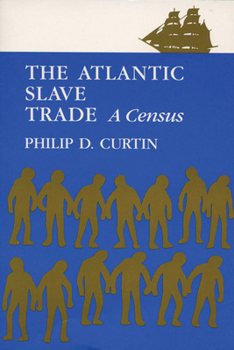The Atlantic Slave Trade: A Census
Select Format
Select Condition 
Book Overview
Curtin combines modern research and statistical methods with his broad knowledge of the field to present the first book-length quantitative analysis of the Atlantic slave trade. Its basic evidence suggests revision of currently held opinions concerning the place of the slave trade in the economies of the Old World nations and their American colonies.
Format:Paperback
Language:English
ISBN:0299054047
ISBN13:9780299054045
Release Date:January 1972
Publisher:University of Wisconsin Press
Length:358 Pages
Weight:1.10 lbs.
Dimensions:0.8" x 5.5" x 8.5"
Customer Reviews
1 rating
Overall, I liked this book.
Published by Thriftbooks.com User , 25 years ago
There are many aspects to the Trans-Atlantic slave trade. There is the issue of the African disporia, where many Africans were taken from their homes to another completely different country. There are the moral issues about slavery and who was involved and to what extent. Also, there are the horrors of the middle passage and the life of the slaves after they reached their destination. In the book The Atlantic Slave Trade: A Census, published by the The University of Wisconsin Press in 1969, the author Philip D. Curtin focuses on the number of slaves that were taken across the Atlantic. Throughout the book the author uses different research methods to express how many Africans were shipped across the Atlantic, from what parts in Africa, and the destination where they were shipped. He uses other historians' estimates and either tries to prove them correct or prove them incorrect. The author's intent on writing this book was to explore old knowledge on the slave trade and not to present new information. His intent was to use old data and publications and come up with his own theories or "synthesis". He does this by using documents and estimations that have already been written. With this information he then tries to correlate them with previous documentation to prove or disprove them. Also, he states that his numbers are not precise and should not be considered exact but only estimations. He did not intend the book to be a definitive study, but a challenge to others, who can, to correct or complete his findings. He also knew that in time with new data and more sophisticated forms of calculation his work might be modified. Another area he did not want to discuss was the morality of the slave trade. This book was not intended to blame any one person or country nor did it discuss the evils of the slave trade. He felt these aspects of the trade have already been proven and in his opinion is no longer disputed. I felt the author did an adequate job presenting and explaining the material. He discusses in detail where he found the information, the name of the historian who first presented the information, and how he proved or disproved the information. He did a great deal of research in finding accurate information and when there was none given he explains how he came to his conclusions and the methods in which he used. However, I would recommend taking a statistics class before reading this book. It goes in depth with various methods and a great deal of numbers. This can be quite confusing at times. It also warrants the reader to re-read certain areas of the book. However, this was his intention because he wanted his readers to think about what he has written and possibly challenge it. The organization of the chapters are in a manner in which the reader can first review some of the previous literature about the numbers of Africans shipped during the slave trade. The first chapter also examines the





